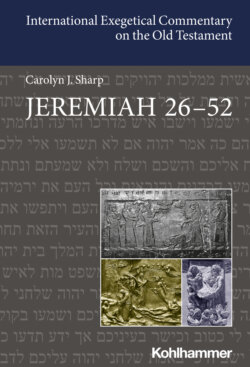Читать книгу Jeremiah 26-52 - Carolyn Sharp - Страница 6
На сайте Литреса книга снята с продажи.
Editors’ Foreword
ОглавлениеThe International Exegetical Commentary on the Old Testament (IECOT) offers a multi-perspectival interpretation of the books of the Old Testament to a broad, international audience of scholars, laypeople and pastors. Biblical commentaries too often reflect the fragmented character of contemporary biblical scholarship, where different geographical or methodological sub-groups of scholars pursue specific methodologies and/or theories with little engagement of alternative approaches. This series, published in English and German editions, brings together editors and authors from North America, Europe, and Israel with multiple exegetical perspectives.
From the outset the goal has been to publish a series that was “international, ecumenical and contemporary.” The international character is reflected in the composition of an editorial board with members from six countries and commentators representing a yet broader diversity of scholarly contexts.
The ecumenical dimension is reflected in at least two ways. First, both the editorial board and the list of authors includes scholars with a variety of religious perspectives, both Christian and Jewish. Second, the commentary series not only includes volumes on books in the Jewish Tanach/Protestant Old Testament, but also other books recognized as canonical parts of the Old Testament by diverse Christian confessions (thus including the deuterocanonical Old Testament books).
When it comes to “contemporary,” one central distinguishing feature of this series is its attempt to bring together two broad families of perspectives in analysis of biblical books, perspectives often described as “synchronic” and “diachronic” and all too often understood as incompatible with each other. Historically, diachronic studies arose in Europe, while some of the better known early synchronic studies originated in North America and Israel. Nevertheless, historical studies have continued to be pursued around the world, and focused synchronic work has been done in an ever greater variety of settings. Building on these developments, we aim in this series to bring synchronic and diachronic methods into closer alignment, allowing these approaches to work in a complementary and mutually-informative rather than antagonistic manner.
Since these terms are used in varying ways within biblical studies, it makes sense to specify how they are understood in this series. Within IECOT we understand “synchronic” to embrace a variety of types of study of a biblical text in one given stage of its development, particularly its final stage(s) of development in existing manuscripts. “Synchronic” studies embrace non-historical narratological, reader-response and other approaches along with historically-informed exegesis of a particular stage of a biblical text. In contrast, we understand “diachronic” to embrace the full variety of modes of study of a biblical text over time.
This diachronic analysis may include use of manuscript evidence (where available) to identify documented pre-stages of a biblical text, judicious use of clues within the biblical text to reconstruct its formation over time, and also an examination of the ways in which a biblical text may be in dialogue with earlier biblical (and non-biblical) motifs, traditions, themes, etc. In other words, diachronic study focuses on what might be termed a “depth dimension” of a given text—how a text (and its parts) has journeyed over time up to its present form, making the text part of a broader history of traditions, motifs and/or prior compositions. Synchronic analysis focuses on a particular moment (or moments) of that journey, with a particular focus on the final, canonized form (or forms) of the text. Together they represent, in our view, complementary ways of building a textual interpretation.
Of course, each biblical book is different, and each author or team of authors has different ideas of how to incorporate these perspectives into the commentary. The authors will present their ideas in the introduction to each volume. In addition, each author or team of authors will highlight specific contemporary methodological and hermeneutical perspectives—e.g. gender-critical, liberation-theological, reception-historical, social-historical—appropriate to their own strengths and to the biblical book being interpreted. The result, we hope and expect, will be a series of volumes that display a range of ways that various methodologies and discourses can be integrated into the interpretation of the diverse books of the Old Testament.
Fall 2012 The Editors
